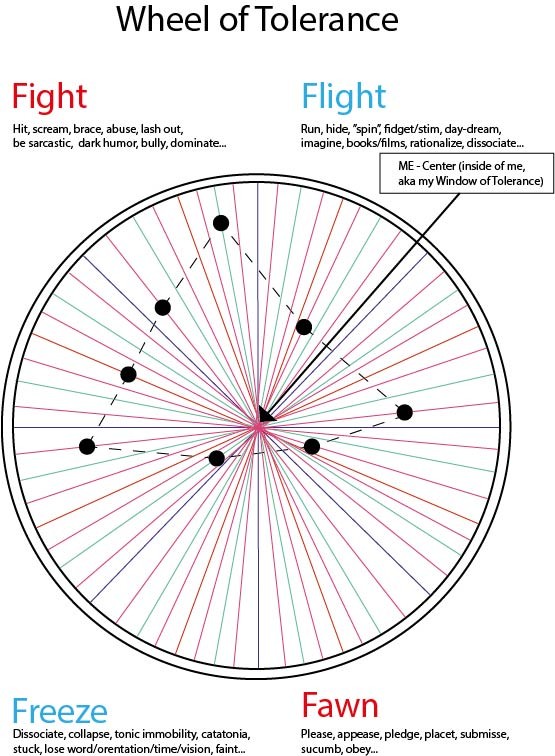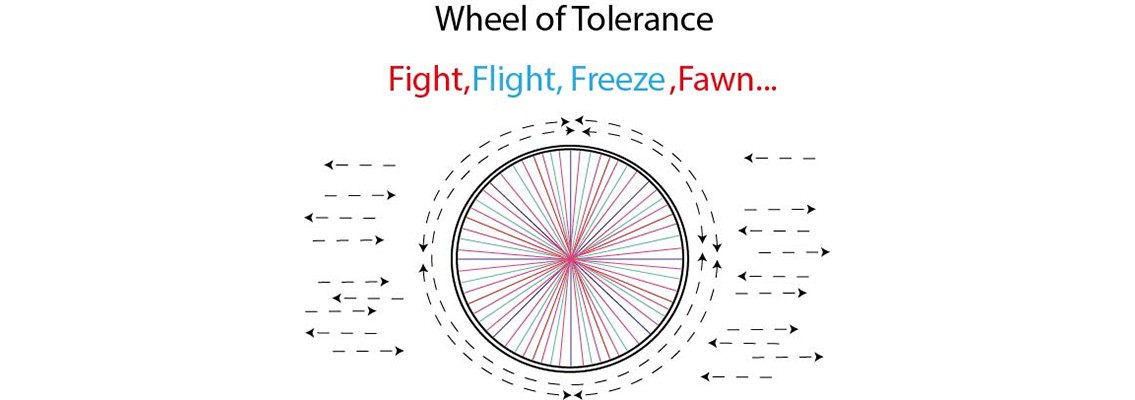The Wheel of Tolerance
I am learning to write from my own perspective and experiences only. Acknowledging that they are not universal. I am also learning no to be ashamed of them, or to be ashamed or feel like a “misfit” because I do not fit into the common theories about how a mind works, or is supposed to work, neither in psychologically healthy – nor unhealthy states. Neither in the everyday life, nor in traumatic situations (or in reliving them).
I don’t like labels. I have been heavily labeled all my life. It has never been helpful to me. I have stopped trying to squeeze myself into existing theories and models. With that said – on to the topic of the Window of Tolerance – or as I call it – to better fit me and my experiences the Weel of Tolerance, I want to share my perspectives and thougts.
The window of tolerance assumes you can only be in one state at a time. It says either you are in your window – or out of it. Either you are in fight, flight, freeze or fawn, but not in two or several states at the same time. It does not acknowledge either (as I understand it) that you can go into freeze, then out of it again into e.g. fight. It pictures freeze as the “end station”, the last resort, a place we go to when all other options are exhausted. It also states that there is no choosing in going into either of these states.
And here I beg to differ. It might just apply to me – but I don’t think so. There must be others who experience the same as I do. I am not that unique. Because my traumatic experiences are not that unique, neither is my resilience or anything else about me.
This is how I picture the Wheel of Tolerance:

The Wheel of Tolerance.
With it I am explaining my experience of being able to be in several stress/trauma responses at the same time. Like this:

The Wheel of Tolerance - in an active and simultaneous response.
Is this because I am so highly dissociative? So fragmented that I am literally “all over the place” at once? Maybe. I definitively can be that – at times.
But… isn’t it possible for all people to be in several emotional states at once? Have several emotions or feelings at once? Like being scared, but feeling joyful at the same time? Feeling curious, but upset at the same time? Feeling scared, joyful, curious and upset at the same time? Even having more contradictory emotions at the same time – feeling love and hate at the same time? Fear and relaxation? Anger and content? What is the difference then if you are in a stress or trauma response? Aren’t they emotional states as well? Is it only highly dissociative people who can be in flight and freeze at the same time? Or move between them – several times – in a traumatic situation – as well as in working with traumatic material, e.g. in therapy?
And here I also want to add that fight, flight, freeze and fawn/please are very rudimentary/basic descriptions of states that can vary a lot. Freeze can mean anything from feeling literally frozen, to curling up as a fetus to fainting and everything in between – and fight can mean passively refusing, staring, screaming, hitting, violently harming someone – etc… These categories of fight, fight, freeze and fawn are very broad categories, with room for very personal experiences, between individuals and within individuals.
Of course, this complicates the role and job of a therapist. It is easier to tell someone what to do with a client that dissociates and go into a more purer form of being “outside their window of tolerance”. If they seem “uppy” – bring them down, if they seem to head “downwards” – bring them up. But if they are both anxious, fidgety, have a hard time to speak, are pleasing and appear to be somewhat passive aggressive, but also not really present, and seems to head towards the door? What do you do then? Bring them up, down?
Is our nervous system designed to only room one emotional state at a time – whether that be a “common” emotional response or a trauma response?
I also want to make a distinction between trauma responses while the trauma happens – and the trauma responses that occurs afterwards. Is the trauma response in the traumatic situation different than what one can see when the trauma is recalled, shows up in a flashback, an intrusive memory, is talked about?
If you used a heavily freeze response during a specific traumatic event – is that where you go when you try to recall it? Is fight, flight, freeze, fawn/please – firstly a response in the traumatic situation – or a defense system? Is there a correlation between what happened – how you defended your mind in the situation, and how you defend your mind when you try to work with your traumatic memory?
And then – there is the discussion about the involuntariness of them. Can you choose your response in the traumatic situation? Can you choose your defense system?
On both questions – from my perspective. I am answering Yes. And no.
Yes. Because if you repeatedly find yourself in the same kind of traumatic situations – you will adapt. You will learn what works, and what does not work. You will also get used to being in your trauma responses – so you will move in and out of them differently. I also think the age when you learned them and how heavily trained/reinforced you were will matter. I think I have heard that soldiers get trained in how to dissociate and how to use it in stressful or traumatic situations. I think this applies to at least some other traumatized people who were more purposefully or maybe more accidentally trained how to respond – and how to use their dissociation. What you learn, what is enforced in traumatic situations – stick. And in my experience – it is very possible to be absolutely terrified and act “logically” (according to the situation at hand) at the same time. It is possible to have tunnel vision out of fear and at the same time please and seemingly take voluntarily part in something.
If freeze was the end station, I can’t see how that would be the optimal way to survival. To do nothing, to act as if dead, to not respond, to not resist – will save you at times. As it will kill you in other situations (or put you in severe harms way) where your ability to get out of a freeze response, or not even go into it – but instead act will secure your survival.
And no. You can choose your response – actively choose it. And yet, you did not choose to be in the situation in the first place. So, you cannot choose whether or not to HAVE a stress/trauma response. As I see it – they more exposed to trauma you get – the better you will become at dealing with it. And the less outside help you have, the more you will have to rely on them. Then they will grow to become part of you – how, and who you are.
So also here – when people tell me I was powerless, had no choices when I experienced my traumas – I feel I do not fit either. I did choose, a lot. I did choose what to do, when to do, how to do, but I did not choose the doing. For me – this too is an important distinction. Yes, I was powerless. And no – I wasn’t. And just because I was not powerless in all choices – I could access resources to save myself. I could access my cognition. I could use my dissociation to my advantage. But it also became automatized. Trained responses. You can be on auto-pilot and “a perfect willingly and participating victim” at the same time.
I want more nuanced discussions about this. I want to broaden the perspectives. And I can’t see how I can do that without using my own experiences. Am I exposing myself when I do? Yes. I am putting myself in a vulnerable situation. Yes. So be it. I am open for discussions. I will keep in mind that my experiences and my perspectives are mine. They do not apply in all situations. But I do think they can be helpful. At least – I hope so. If not – they are helping me. My experiences are human experiences.
I am open for feedback and discussions. I will share my perspectives and experiences. I will explain my experiences as good as I can. Maybe others will be able to relate to them too. If not – they are still my experiences.
Text and pictures are copyright protected.© Live the Change, Katarina Lundgren 2019
When you subscribe to the blog, we will send you an e-mail when there are new updates on the site so you wouldn't miss them.


Comments